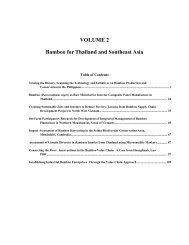WBC-VIII-Vol.4 – Resources – Forestry, Plantations and ... - BambuSC
WBC-VIII-Vol.4 – Resources – Forestry, Plantations and ... - BambuSC
WBC-VIII-Vol.4 – Resources – Forestry, Plantations and ... - BambuSC
Create successful ePaper yourself
Turn your PDF publications into a flip-book with our unique Google optimized e-Paper software.
The Preservation of Bamboo Forests undertaken by NPO<br />
Kitakyushu Biotope Network Group in Kitakyushu, Japan<br />
Abstract<br />
Bart DEWANCKER 1 , Toshiichi KUSABA 2<br />
1 Associate Professor, The University of Kitakyushu, Faculty of Environmental Engineering<br />
2 Engineering Advisor, The University of Kitakyushu Faculty of Environmental Engineering<br />
In Japan, nearly all the bamboo forests are not maintained any longer, <strong>and</strong> because bamboos are very fast<br />
growing, this result in a rapid exp<strong>and</strong>ing spread of large bamboo forests. There are now devastating problems<br />
occurring for the bamboo forests, which are invading the adjacent forests <strong>and</strong> surrounding areas. Bamboo forest<br />
thinning had always been the solution to prevent damage of such spread of bamboo forests to other tree varieties<br />
<strong>and</strong> the surrounding fields. Especially since there is no longer a large dem<strong>and</strong> for bamboo material, as well as<br />
the high loan costs in Japan, bamboo forest thinning is quite difficult to undertake. In Kitakyushu (Japan), the<br />
NPO Kitakyushu Biotope Network Group undertakes thinning of bamboo forests through participation of<br />
citizens, company employees, all of them are volunteers. Since November 2001, several environmental<br />
preservation activities were organized with the goal of preserving the bamboo forests in danger. Some of the<br />
main purposes of these activities were to make the citizens <strong>and</strong> the local government aware of the aggravating<br />
<strong>and</strong> severe problems <strong>and</strong> try to find also ways for the use of bamboo material. Already more than 2000 citizens<br />
have participated in these activities, <strong>and</strong> several hectares of bamboo forest are being maintained. Most of the<br />
bamboo material was chipped <strong>and</strong> the chipped bamboo material had been used for making of soil products.<br />
Introduction - Problems which are facing the bamboo forests<br />
In former times, bamboo has played a crucial role in the daily life of many Japanese people. Bamboo was used<br />
as building material, in fishery <strong>and</strong> agriculture, <strong>and</strong> as a basic material for making daily life tools <strong>and</strong> utensils.<br />
Moreover, bamboo sprouts were <strong>and</strong> still are a much loved food in Japan. Most probably, bamboo charcoal was<br />
used as energy resource as well. The change from an agricultural society into an industrial society, which means<br />
changes in life style, resulted in the fact that there was less need for bamboo material. Above that, the very high<br />
loan costs in Japan are another main reason for the import of cheaper bamboo sprouts <strong>and</strong> with bamboo<br />
prefabricated building material <strong>and</strong> other tools, mainly from China <strong>and</strong> other Asian countries, resulting in less<br />
dem<strong>and</strong> for local bamboo. Since there is no longer any market for the local bamboo material, the bamboo forests<br />
cannot be maintained any longer (figure 1 <strong>and</strong> figure 2).<br />
<strong>VIII</strong> World Bamboo Congress Proceedings Vol 4-105




